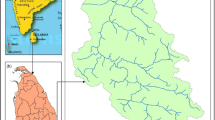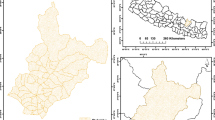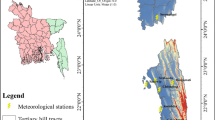Abstract
Due to the effect on land degradation, soil fertility, and agricultural production, the soil erosion becomes one of the major environmental problems and concerning issues of the world in the twenty-first century. Thus the investigation of soil erosion loss and risk is very crucial. The present study aims to estimate the potential and actual soil erosion in Haryana (covering a part of Indo-Gangetic regions) using the Revised Universal Soil Loss Equation (RUSLE) model integrated with geospatial technology. Input datasets for RUSLE model were taken from various sources includes rainfall erosivity (R), soil erodibility (K), topographic factor (LS), cover management factor (C), and support practice (P) and processed in GIS software platform. The values for these parameters were ranging from 160 to 683, 0.000 to 0.065, 0.0 to 232, 0 to 0.95, and 0.55 to 1 respectively. An updated LULC were mapped using Landsat-8 satellite data of 2021, with an overall accuracy of 84.89% (Kappa = 0.82) covering 8 categories. The erosion rates were varying from 0 to 130 t ha−1 y−1 for both the actual and potential soil erosion. A total of 19,289,370 t y−1 soil erosion was estimated in the State. Most of the State area (99.27%) was under the low-erosion zone (0–5 t ha−1 y−1) due to flat terrain, uniform C factor, and lower P values. The obtained results also reveal that the high/extreme severe soil erosion is spread in the northwest, northern, and eastern parts of Haryana, especially in the hills and riverine areas of Yamuna and Ghaggar watersheds (20–130 t ha−1 y−1) due to high magnitude of R, K, and C. The RUSLE model integrated with geospatial technology provides a quantitative approach to estimate soil erosion, which can be applicable for a large landscape and supports the implementation of conservation and management planning at the local and regional levels.










Similar content being viewed by others
Availability of data and material
Data will be provided by the corresponding author on request.
References
Alexakis DD, Hadjimitsis DG, Agapiou A (2013) Integrated use of remote sensing, GIS and precipitation data for the assessment of soil erosion rate in the catchment area of “Yialias” in Cyprus. Atmos Res 1(131):108–124
Anees MT, Abdullah K, Nawawi MNM, Norulaini NAN, Syakir MI, Omar AKM (2018) Soil erosion analysis by RUSLE and sediment yield models using remote sensing and GIS in Kelantan state. Penins Malays 54(4):356–372. https://doi.org/10.1071/SR17193
Ashiagbor G, Forkuo EK, Laari P, Aabeyir R (2012) Modeling soil erosion using rusle and GIS tools. Intl J R S Geo (IJRSG) 2(2016):7–17
Bagwan WA, Gavali RS (2021) Delineating changes in soil erosion risk zones using RUSLE model based on confusion matrix for the Urmodi river watershed, Maharashtra, India. Model Earth Syst Environ 7(3):2113–2126. https://doi.org/10.1007/s40808-020-00965-w
Banko G (1998) A review of assessing the accuracy of and of methods including remote sensing data in forest inventory. Int Inst Appl Syst Anal, Interim Report IT-98-081, November, Laxenburg, Austria
Biswas SS, Pani P (2015) Estimation of soil erosion using RUSLE and GIS techniques: a case study of Barakar River basin, Jharkhand, India. Model Earth Syst Environ 1(4):1–13. https://doi.org/10.1007/s40808-015-0040-3
Borrelli P, Robinson DA, Fleischer LR, Lugato E, Ballabio C, Alewell C, Meusburger K, Modugno S, Schütt B, Ferro V, Bagarello V (2017) An assessment of the global impact of 21st century land use change on soil erosion. Nat Commun 8(1):1–13. https://doi.org/10.1038/s41467-017-02142-7
Cerdan O, Govers G, Le Bissonnais Y, Van Oost K, Poesen J, Saby N, Dostal T (2010) Rates and spatial variations of soil erosion in Europe: a study based on erosion plot data. Geomorphology 122(1–2):167–177. https://doi.org/10.1016/j.geomorph.2010.06.011
Chatterjee S, Krishna AP, Sharma AP (2014) Geospatial assessment of soil erosion vulnerability at watershed level in some sections of the Upper Subarnarekha river basin, Jharkhand, India. Environ Earth Sci 71(1):357–374. https://doi.org/10.1007/s12665-013-2439-3
Cheema MJM, Bastiaanssen WG (2010) Land use and land cover classification in the irrigated Indus Basin using growth phenology information from satellite data to support water management analysis. Agri Water Manag 97(10):1541–1552. https://doi.org/10.1016/j.agwat.2010.05.009
Chughtai AH, Abbasi H, Karas IR (2021) A review on change detection method and accuracy assessment for land use land cover. R S Appl Soc Environ 22:100482. https://doi.org/10.1016/j.rsase.2021.100482
Chuma GB, Bora FS, Ndeko AB, Mugumaarhahama Y, Cirezi NC, Mondo JM, Bagula EM, Karume K, Mushagalusa GN, Schimtz S (2022) Estimation of soil erosion using RUSLE modeling and geospatial tools in a tea production watershed (Chisheke in Walungu), eastern Democratic Republic of Congo. Model Earth Syst Environ 8(1):1273–1289. https://doi.org/10.1007/s40808-021-01134-3
Clayton ES (1941) Soil erosion. Austr Surv 8:5. https://doi.org/10.1080/00050326.1941.10437468
De Jong SM, Paracchini ML, Bertolo F, Folving S, Megier J, De Roo AP (1999) Regional assessment of soil erosion using the distributed model SEMMED and remotely sensed data. CATENA 37(3):291–308. https://doi.org/10.1016/S0341-8162(99)00038-7
Dutta D, Das S, Kundu A, Taj A (2015) Soil erosion risk assessment in Sanjal watershed, Jharkhand (India) using geo-informatics, RUSLE model and TRMM data. Model Earth Syst Environ 1(4):1–9. https://doi.org/10.1007/s40808-015-0034-1
Ebabu K, Tsunekawa A, Haregeweyn N, Adgo E, Meshesha DT, Aklog D, Yibeltal M (2019) Effects of land use and sustainable land management practices on runoff and soil loss in the Upper Blue Nile basin, Ethiopia. Sci Total Environ 648:1462–1475. https://doi.org/10.1016/j.scitotenv.2018.08.273
Farhan Y, Nawaiseh S (2015) Spatial assessment of soil erosion risk using RUSLE and GIS techniques. Environ Earth Sci 74(6):4649–4669. https://doi.org/10.1007/s12665-015-4430-7
Fayas CM, Abeysingha NS, Nirmanee KG, Samaratunga D, Mallawatantri A (2019) Soil loss estimation using rusle model to prioritize erosion control in KELANI river basin in Sri Lanka. Int Soil Water Conserv Res 7(2):130–137. https://doi.org/10.1016/j.iswcr.2019.01.003
Ganasri BP, Ramesh H (2016) Assessment of soil erosion by RUSLE model using remote sensing and GIS—a case study of Nethravathi Basin. Geosci Front 7(6):953–961. https://doi.org/10.1016/j.gsf.2015.10.007
Haregeweyn N, Tsunekawa A, Poesen J, Tsubo M, Meshesha DT, Fenta AA, Adgo E (2017) Comprehensive assessment of soil erosion risk for better land use planning in river basins: case study of the Upper Blue Nile River. Sci Total Envir 574:95–108. https://doi.org/10.1016/j.scitotenv.2016.09.019
Jahun BG, Ibrahim R, Dlamini NS, Musa SM (2015) Review of soil erosion assessment using RUSLE model and GIS. J Biol Agric Health 5(9):36–47. www.iiste.org
Jain M, Dawa D, Mehta R, Dimri AP, Pandit MK (2016) Monitoring land use change and its drivers in Delhi, India using multi-temporal satellite data. Mdl Earth Systm Envir 2(1):1–14. https://doi.org/10.1007/s40808-016-0075-0
Jasrotia AS, Dhiman SD, Aggarwal SP (2002) Rainfall-runoff and soil erosion modeling using remote sensing and GIS technique- a case study of tons watershed. J Ind Soci R S 30(3):167–180. https://doi.org/10.1007/BF02990649
Jones N, De Graaff J, Rodrigo I, Duarte F (2011) Historical review of land use changes in Portugal (before and after EU integration in 1986) and their implications for land degradation and conservation, with a focus on Centro and Alentejo regions. Appli Geo 31(3):1036–1048. https://doi.org/10.1016/j.apgeog.2011.01.024
Karydas CG, Panagos P, Gitas IZ (2014) A classification of water erosion models according to their geospatial characteristics. Int J Digit Earth 7(3):229–250. https://doi.org/10.1080/17538947.2012.671380
Kavian A, Sabet SH, Solaimani K (2016) Simulating the effects of land use changes on soil erosion using RUSLE model. 6049 (January). https://doi.org/10.1080/10106049.2015.1130083.
Kebede YS, Endalamaw NT, Sinshaw BG, Atinkut HB (2021) Modeling soil erosion using RUSLE and GIS at watershed level in the upper beles, Ethiopia. Environ Chall 1(2):100009. https://doi.org/10.1016/j.envc.2020.100009
Khademalrasoul A, Amerikhah H (2021) Assessment of soil erosion patterns using RUSLE model and GIS tools (case study: the border of Khuzestan and Chaharmahal Province, Iran). Model Earth Syst Environ 7(2):885–895. https://doi.org/10.1007/s40808-020-00931-6
Kidane M, Bezie A, Kesete N, Tolessa T (2019) The impact of land use and land cover (LULC) dynamics on soil erosion and sediment yield in Ethiopia. Heliyon 5(12):e02981. https://doi.org/10.1016/j.heliyon.2019.e02981
Knisel WG (1987) Soil erosion and crop productivity. Soil Sci 144(5):384. https://doi.org/10.1097/00010694-198711000-00011
Kouli M, Soupios P, Vallianatos F (2009) Soil erosion prediction using the revised universal soil loss equation (RUSLE) in a GIS framework, Chania, Northwestern Crete. Greece Environ Geol 57(3):483–497. https://doi.org/10.1007/s00254-008-1318-9
Kumar S, Kushwaha SPS (2013) Modelling soil erosion risk based on RUSLE-3D using GIS in a Shivalik sub-watershed. J Earth Syst Sci 122(2):389–398. https://doi.org/10.1007/s12040-013-0276-0
Lee S (2004) Soil erosion assessment and its verification using the universal soil loss equation and geographic information system: a case study at Boun. Korea Environ Geol 45(4):457–465. https://doi.org/10.1007/s00254-003-0897-8
Lee E, Ahn S, Im S (2017) Estimation of soil erosion rate in the democratic People’s Republic of Korea using the RUSLE model. Frst Sci Tech. https://doi.org/10.1080/21580103.2017.1341435
Li S, Lobb DA, Lindstrom MJ, Farenhorst A (2007) Tillage and water erosion on different landscapes in the northern North American Great Plains evaluated using 137Cs technique and soil erosion models. CATENA 70(3):493–505. https://doi.org/10.1016/j.catena.2006.12.003
Luca M, Badraoui M, Chude Vi, Costa I, Baptista, saurinda DS, Mamo T, Yemefack M, Aulang MS, Yagi K, Hong SY, Vijarnsorn P, Zhang GL, Arrouays D, Black H, Krasilnikov P, Sobocá J, Alegre J, Henriquez CR, Mendonça-Santos, MdeL, McKenzie N (2015) Status of the world’s soil resources. In: Intergovernmental Technical Panel on Soils. http://www.fao.org/3/a-i5199e.pdf.
Mahala A (2018) Soil erosion estimation using RUSLE and GIS techniques—a study of a plateau fringe region of tropical environment. Arab J Geosci 11(13):1–18. https://doi.org/10.1007/s12517-018-3703-3
Marondedze AK, Schütt B (2020) Assessment of soil erosion using the rusle model for the Epworth district of the harare metropolitan province, zimbabwe. Sustainability (Switzerland) 12(20):1–24. https://doi.org/10.3390/su12208531
McBratney A, Field DJ, Koch A (2014) The dimensions of soil security. Geoderma 213:203–213. https://doi.org/10.1016/j.geoderma.2013.08.013
Mohajane M, Essahlaoui A, Oudija F, Hafyani ME, Hmaidi AE, Ouali AE, Randazzo G, Teodoro AC (2018) Land use/land cover (LULC) using landsat data series (MSS, TM, ETM+ and OLI) in Azrou forest, in the Central Middle Atlas of Morocco. Environments 5(12):131. https://doi.org/10.3390/environments5120131
Mohamed C, Shantha N (2019) International soil and water conservation research soil loss estimation using rusle model to prioritize erosion control in KELANI river basin in Sri Lanka. Int Soil Water Conserv 7(2):130–137. https://doi.org/10.1016/j.iswcr.2019.01.003
Mohammadi M, Sharifi A (2021) Evaluation of convolutional neural networks for urban mapping using satellite images. J Ind Soci R S 49(9):2125–2131. https://doi.org/10.1007/s12524-021-01382-x
Mohammed S, Alsafadi K, Talukda S, Kiwan S, Hennawi S, Alshihabi O, Sharaf M, Harsanyie E (2020) Estimation of soil erosion risk in southern part of Syria by using RUSLE integrating geo informatics approach. R S Appl Soc Envirom 20:100375. https://doi.org/10.1016/j.rsase.2020.100375
Mohan KB, Kumaraswamy VK (2015) Estimation of soil erosion in a semi-arid watershed of Tamil Nadu (India) using revised universal soil loss equation ( rusle ) model through GIS. Model Earth Syst Environ 1(3):1–17. https://doi.org/10.1007/s40808-015-0015-4
Mohapatra R (2022) Application of revised universal soil loss equation model for assessment of soil erosion and prioritization of ravine infested sub basins of a semi-arid river system in India. Model Earth Syst Environ. https://doi.org/10.1007/s40808-022-01388-5
Nitheshnirmal S, Thilagaraj P, Rahaman SA, Jegankumar R (2019) Erosion risk assessment through morphometric indices for prioritisation of Arjuna watershed using ALOS-PALSAR DEM. Model Earth Syst Environ 5(3):907–924. https://doi.org/10.1007/s40808-019-00578-y
Nyakatawa EZ, Jakkula V, Reddy KC, Lemunyon JL (2007) Soil erosion estimation in conservation tillage systems with poultry litter application using RUSLE 2.0 model. Soil Tillage Res 94:410–419. https://doi.org/10.1016/j.still.2006.09.003
Pan J, Wen Y (2014) Estimation of soil erosion using RUSLE in Caijiamiao watershed, China. Nat Hazards 71(3):2187–2205. https://doi.org/10.1007/s11069-013-1006-2
Pimentel D (1993) World soil erosion and conservation. Cambridge University Press, Cambridge. https://doi.org/10.2134/jeq1994.00472425002300020035x
Pimentel D, Burgess M (2013) Soil erosion threatens food production. Agriculture 3(3):443–463. https://doi.org/10.3390/agriculture3030443
Punia M, Joshi PK, Porwal MC (2011) Decision tree classification of land use land cover for Delhi, India using IRS-P6 AWiFS data. Exp Syst Appl 38(5):5577–5583. https://doi.org/10.1016/j.eswa.2010.10.078
Rather IA, Dar AQ (2020) Assessing the impact of land use and land cover dynamics on water quality of Dal Lake, NW Himalaya, India. Appl Water Sci 10(10):1–18. https://doi.org/10.1007/s13201-020-01300-5
Renard KG, Ferreira VA (1993) RUSLE model description and database sensitivity. J Environ Qual 22(3):458–466. https://doi.org/10.2134/jeq1993.00472425002200030009x
Renard KG, Foster GR, Weesies GA, Porter JP (1991) RUSLE: revised universal soil loss equation. J Soil Water Consr 46:30–33
Roy PS, Roy A, Joshi PK, Kale MP, Srivastava VK, Srivastava SK, Kushwaha D (2015) Development of decadal (1985–1995–2005) land use and land cover database for India. R S 7(3):2401–2430. https://doi.org/10.3390/rs70302401
Sarathi S, Padmini B (2015) Estimation of soil erosion using RUSLE and GIS techniques: a case study of Barakar River basin, Jharkhand, India. Model Earth Syst Environ 1(4):1–13. https://doi.org/10.1007/s40808-015-0040-3
Senanayake S, Pradhan B, Huete A, Brennan J (2020) A review on assessing and mapping soil erosion hazard using geo-informatics technology for farming system management. R S 12(24):4063. https://doi.org/10.3390/rs12244063
Sharma T, Singh O (2017) Soil erosion susceptibility assessment through geo-statistical multivariate approach in Panchkula district of Haryana, India. Model Earth Syst Environ 3(2):733–753. https://doi.org/10.1007/s40808-017-0331-y
Shit PK, Nandi AS, Bhunia GS (2015) Soil erosion risk mapping using RUSLE model on jhargram sub-division at West Bengal in India. Model Earth Syst Environ 1(3):1–12. https://doi.org/10.1007/s40808-015-0032-3
Singh D, Singh S, Lekshmi VR, Dutta S, Ali MS, Ahmed A (2014) Species type and forest health assessment via hyperspectral remote sensing in the part of Himalayan range, India. Dhaka Univ J Biol Sci 23(2):135–146. https://doi.org/10.3329/dujbs.v23i2.20093
Singh D, Kundu N, Ghosh S (2021a) Mapping rice residues burning and generated pollutants using Sentinel-2 data over northern part of India. Remote Sens Appl Soc Environ 22:100486. https://doi.org/10.1016/j.rsase.2021.100486
Singh RK, Singh P, Drews M, Kumar P, Singh H, Kumar GAK (2021b) A machine learning-based classification of LANDSAT images to map land use and land cover of India. R S Appl Soc Environ 24:100624. https://doi.org/10.1016/j.rsase.2021.100624
Singh D, Kumar P, Partibha S, Chauhan N, Attri P, Singh S (2022) Satellite-based crop typing at cadastral level using traditional and machine learning methods. AMA 53(4): 7095–7116. https://www.shin-norinco.com/volume/AMA/53/04/satellite-based-crop-typing-at-cadastral-level-using-traditional-and-machine-learning-methods-62612fda97f42.pdf.
Thapa P (2020) Spatial estimation of soil erosion using RUSLE modeling: a case study of Dolakha district, Nepal. Environ Syst Res 9(1):1–10. https://doi.org/10.1186/s40068-020-00177-2
Tian H, Banger K, Bo T, Dadhwal VK (2014) History of land use in India during 1880–2010: large-scale land transformations reconstructed from satellite data and historical archives. Glob Planet Change 121:78–88. https://doi.org/10.1016/j.gloplacha.2014.07.005
Wischmeier WH, Smith DD (2022) Predicting rainfall erosion losses—a guide to conservation planning. Available online: http://naldc.nal.usda.gov/download/CAT79706928/PDF. Accessed on 12 Sep 2022
Xue J, Lyu D, Wang D, Wang Y, Yin D, Zhao Z, Mu Z (2018) Assessment of soil erosion dynamics using the GIS-based RUSLE model: a case study of wangjiagou watershed from the three Gorges reservoir region Southwest China. Water 10(12):1817. https://doi.org/10.3390/w10121817
Zachar D (1983) Soil erosion: developments in soil science. Soil science. Elsevier, Amsterdam
Zeleke G, Hurni H (2001) Implications of land use and land cover dynamics for mountain resource degradation in the North-western Ethiopian highlands. Moun Res Dev 21(2):184–191. https://doi.org/10.1659/0276-4741(2001)021[0184:IOLUAL]2.0.CO;2
Zhao W, Wei H, Jia L, Daryanto S, Zhang X, Liu Y (2018) Soil erodibility and its influencing factors on the Loess Plateau of China: a case study in the Ansai watershed. Solid Earth 9(6):1507–1516. https://doi.org/10.5194/se-9-1507-2018
Acknowledgements
Authors acknowledge to United States Geological Survey (USGS) for providing the Landsat satellite data through Earth Explorer. The Director HARSAC is acknowledged for providing the Lab facility.
Funding
No Funding.
Author information
Authors and Affiliations
Corresponding author
Ethics declarations
Conflicts of interest
There is no conflict of interest.
Additional information
Publisher's Note
Springer Nature remains neutral with regard to jurisdictional claims in published maps and institutional affiliations.
Rights and permissions
Springer Nature or its licensor holds exclusive rights to this article under a publishing agreement with the author(s) or other rightsholder(s); author self-archiving of the accepted manuscript version of this article is solely governed by the terms of such publishing agreement and applicable law.
About this article
Cite this article
Kumar, S., Singh, D., Kumar, A. et al. Estimation of soil erosion in indo-gangetic region using revised universal soil loss equation (RUSLE) model and geospatial technology. Model. Earth Syst. Environ. 9, 1251–1273 (2023). https://doi.org/10.1007/s40808-022-01553-w
Received:
Accepted:
Published:
Issue Date:
DOI: https://doi.org/10.1007/s40808-022-01553-w




